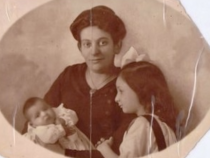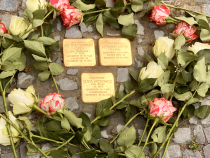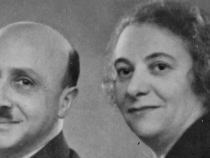Gertrud Dorothea Jacobowitz was born in Halle /Saale on May 13th 1892. Gertrud's parents were Adolf Jacobowitz and Bianka, née Frank. On November 27, 1913, she married Hermann Coper. At the time of their marriage, Gertrud's mother was already deceased (1861 - 1899).
Hermann Coper worked as a fur buyer in ladies' clothing.
On October 3, 1914, their daughter Bianca was born, named after Gertrud's mother
During World War I, Hermann Coper was a front-line soldier.
On January 20, 1920, their daughter Ilse Henriette was born, named after Hermann's mother.
The family lived at Birkbuschstraße 6 in Steglitz.
In 1919 they moved to Friedenau, initially living on Fröaufstraße.
In April 1930, the family moved to Bismarckstr. 8 in Friedenau - from 1937 Jänischallee, since 1947 Sarrazinstraße 22 - into the house that belonged to Adolf Jacobowitz's second wife. It was a large tenement house; in 1938, fourteen tenants were listed in it.
Clara Jacobowitz, née Wolff, born on June 7, 1867 in Groß Strehlitz, Upper Silesia, had married Adolf Jacobowitz on December 31, 1915 in Berlin Friedenau. She gave as her occupation: Private teacher; Adolf was a pensioner.
The family had their own four-room apartment in this house. The family's relationship with Gertrud's stepmother must have been very good, because Ilse Henriette writes in her curriculum vitae that her step-grandmother - Clara Jacobowitz - wanted to pay for both the costs of the Lyceum and her later studies in chemistry.
The elder daughter Bianca attended the Lorenz Lyceum after elementary school. In April 1931 she graduated from high school and had particularly good grades in English and French. To perfect her language skills, she moved to London to live with her mother's relatives. There she attended the business school "Clark's College", where she learned English and French correspondence. In June 1934 she returned to Berlin to take up a position as a foreign correspondent. However, this plan could not be realized due to Nazi decrees against Jews. Bianca had to report regularly to the foreign department of the NSDAP, where she was questioned about Germans living in London. She gave private language lessons and attended the private fashion drawing school of Feige-Strassburger in Berlin-Wilmersdorf as well as the Hirsch'sche Cutting School at Spittelmarkt. After completing this training, she worked as a dressmaker.
After elementary school, Ilse Henriette also attended the Lorenz Lyceum in Friedenau on Schmargendorfer Strasse. After Hitler's seizure of power, she was still able to attend the Gymnasium because her father had been a front-line soldier in the First World War. She was the only Jew in her class. In 1935 she was in the lower Secondary class. After graduating from high school, she wanted to study chemistry, but her parents sent her to England, where she had to work as a seamstress in factories at the age of fifteen.
Her sister Bianca was sent by her parents to London on the last day of 1938 to visit her sister Ilse Henriette. During this stay, she was told by her parents that passports would be revoked from returning Jews from abroad and that she should therefore stay in England.
She had no work in England until July 1939. Eventually she worked for two years as a domestic servant for families in London and Kent. In 1940, she had a job as a dressmaker in a London dress shirt factory.
The girls' parents also wanted to emigrate, but they were unable to do so.
On November 13, 1941, they had to fill out sixteen-page declarations of assets.
Gertrud entered in the list that she had to do forced labor at the cap and uniform factory Carl Halfar and received a monthly wage of 42 RM. She worked in the factory as a Fabricate for cork helmets, i.e. for pith helmets made of cork.
Hermann was a warehouse worker at the Reich tire warehouse of Military district command III and received an hourly wage of 71 1/2 pfennigs.
Both meticulously filled out the forms - from closet to terry cloth to personal clothing. Hermann: 1 hat, 1 sweater, 1 pair of gloves. Gertrud: 1 wool dress, 1 silk dress,1 handbag. Both also stated their joint financial "assets" at 462 RM. But: Both Hermann and Gertrud entered in the list that they had no children - neither in their household, nor outside. They certainly wanted to protect Bianca and Ilse Henriette.
The order that their property had been confiscated "for the benefit of the German Reich" was served on them by the bailiff.
On November 17, 1941, they were deported together to Kovno (Kaunas) in Wehrmacht-occupied Lithuania. They were murdered immediately after their arrival. Hermann Coper was 56 and Gertrud Coper was 50 years old.
When the couple had already been murdered in Kovno, their last belongings were listed, valued and collected:
The inventory of the apartment was valued at 100 RM and the amount was transferred to the city bank.
In December 1941, a residual wage for Hermann in the amount of 3 RM and 4 pfennigs was transferred to the tax office.
In April 1943, the Commerzbank transferred the family's savings balance of RM 528.95 to the tax office.
In June 1944 (!), GASAG transferred RM 11.18 to the tax office. This was a credit balance that had resulted from the advance payment for gas delivery.
Clara Jacobowitz still lived in the house until 1942. She had to experience how Gertrud and Hermann were deported. Less than a year later, on September 14, 1942, she was taken to Theresienstadt. The train departed from Berlin-Moabit (Putlitzstrasse) and arrived in Theresienstadt one day later. The Gestapo ordered a train from the Deutsche Reichsbahn, and it was provided under the number Da 514. The so-called 2nd Great Old Age Transport consisted of 1000 people, including 82 residents of the Berlin Home for the Blind and Deaf. Clara died shortly after her arrival, on October 31, 1942. She was 74 years old.
Bianca worked as a correspondent for the English Tracing Service in London from 1944 to 1946. Bianca married Dr. jur. Ernst Salinger, born on May 3, 1882, in 1944. Ernst Salinger was also from Berlin and was described in the marriage certificate as a baker. It was his third marriage. Their son Ralph was born on December 2, 1946. Ernst Salinger died in February 1950, and Bianca did not return to work until January 1958, working part-time as a stenographer.
Bianca married Siegfried Rothmann in her second marriage. The couple lived in Wellington, New Zealand. Siegfried Rothman died here in February 1985.
Bianca moved to Israel to live with her son Ralph. She died July 4, 2004, in Kfar Ruppin, a kibbutz in northern Israel.
On March 10, 1946, Ilse Henriette married Erich Siegfried Wolffberg, a widower who had fled Frankfurt am Main. On October 23, 1953, their daughter Doreen was born. At that time, she was employed as a seamstress.
Doreen married Barry Sarl. They had two children: Sabrina, born July 28, 1989, and Eliot, born May 18, 1992.






